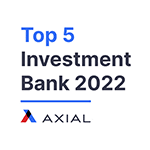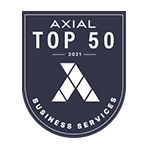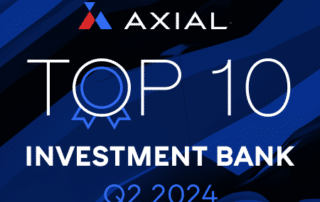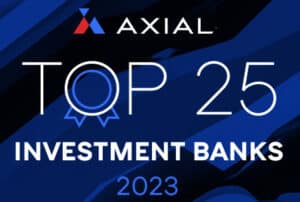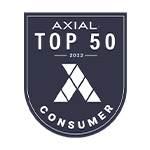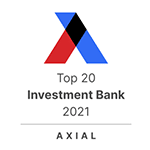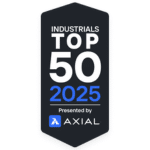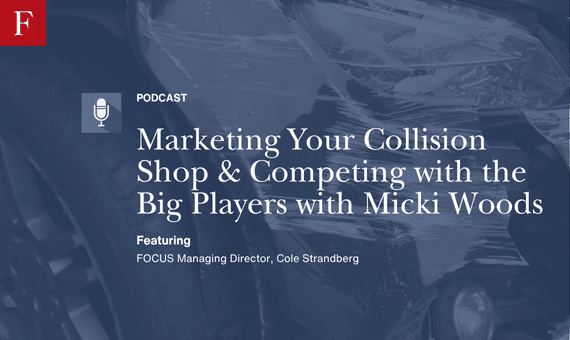
Marketing Your Collision Shop & Competing with the Big Players with Micki Woods
On this week’s episode, Cole Strandberg chats with Micki Woods, founder of Micki Woods Marketing, host of the popular Body Bangin’ Podcast, and one of the industry’s most recognized voices when it comes to helping collision centers develop high-impact marketing strategies. From building a local brand that stands out, to effectively reaching your ideal customers, Micki brings practical, proven insight for shops of all sizes—especially those trying to compete with national consolidators.
Listen and Follow The Collision Vision.
Cole Strandberg: Looking forward to an awesome conversation. It’s a lot of fun working with an absolute professional from the podcast and media world. And we’ll talk about some of that today. But I I want to dive into the marketing piece of the equation primarily. But first, I think everyone knows Micki Woods, but who is Micki Woods? Would love for you to introduce yourself in your own words.
Micki Woods: Who is she? Oh my gosh. So I’ve been in the industry for what feels like forever. I’m a former shop owner. And then I started doing marketing. Once I got out of that, started doing marketing for shops. And that just became really my heart to help other independent shop owners. Having sat in that seat. That’s my passion, is to help because I know how difficult it is. So. Yeah, So branched out and started doing marketing and then started the Body Banging podcast a couple of years ago. So I got that going and I always have things in the works call. So just stay tuned. There’s always more. I host a couple of events. We have the Collision cocktail hour every month. It’s open for collision shops and do some things with OEC. Just, you know, a little bit of everywhere, do some right everywhere. Business, Yeah, all the things.
Cole Strandberg: Everywhere. I love it. You’re in beautiful Southern California, but you don’t strike me as one to sit around sipping my ties on the beach. You are moving and shaking. There is time for that too, I’m sure.
Micki Woods: There’s time my friend there.
Cole Strandberg: I love it. Awesome. Well, appreciate you taking some time with us today. It should be an awesome conversation. I wanna start and dive into the subject of this month series and that is of course, marketing. So I want to start with the negative. What are some of the biggest marketing mistakes you’re seeing shops making in today’s super weird environment?
Micki Woods: Yeah, it is weird right now. I mean, the economy is weird. Shops are all of a sudden now slow. They went from being so crazy busy to now all of a sudden being so slow that they’re dying for work. So one thing that I see a lot of shops doing is going towards social media and doing a huge push into social media and thinking that if they’re on there, all of a sudden they’re going to be some mega influencer. Like they create a like a, a TikTok page or something. And all of a sudden, like, where’s all the business? And that’s an issue that people had when Facebook came around that they thought, well, if I make a Facebook business page, then my business will explode. And that’s not necessarily the case. So I see a lot of shops feeling like that’s what they should do and dumping a bunch of money into it. And there’s really not a big ROI on it. There’s a caveat. Some folks do it really well and it works great for them. For 99% of the rest of shops, it’s really just no ORROI. So I think that’s a huge mess. There’s they get lured in by the magazines because magazines are trying to sell, sell the sponsorship spots because they are slow also. And again, we just don’t see a big ROI with magazine ads and billboards. You know, we’re at we’re in on what is it as needed business type. We don’t, we’re not selling tacos. People need to eat three times a day. I eat more than that. We you need us when you need us. So billboards aren’t going to provide a huge ROI. So I think the social media piece, and we’ve got to be careful as business owners that it’s not our ego we’re trying to feed, that it’s actually our businesses we’re trying to feed, if that makes sense.
Cole Strandberg: Makes total sense. And yeah, it’s so many. We could have a whole show just based on diving a little bit into that, like minute and 1/2 right there. There’s a lot there. Number one, I hope we’re eating three times a day. I hope we’re not dealing with collision repairers 3 times a day as a consumer. That would not be good. And and So what you’re telling me is by starting a Tiktok page, we cannot all immediately be Micki day one and have this following. What the heck? That’s right. We’re we’re bursting somebody’s bubble here. No, makes makes total sense. And I think there’s a key difference too between branding and marketing. And I want to dive a little bit into that. Marketing, to me, it drives revenue, Branding creates, it’s longer term. And I think we might view these things as the same, but they’re often very, very different. It’s been something I’ve preached on throughout kind of this COVID boom was you need to keep the pedal down. Yes, you’re full now, but this will not last forever. And we’re seeing that come into fruition. Why do you think so many owners treat marketing like an afterthought, or really only invest in it in times like some folks are facing today when they’re slow?
Micki Woods: I think they really don’t see the value in it, Cole. They in their minds, they figure and I talk with shops all across the country and Canada and everywhere else, they think that the customer’s going to file the claim, the insurance company is going to tell them where to go and the customer’s just going to go there. There’s really no in between. Or they’re just going to go where a family member said they’re not really valuing the customer journey and understanding that it’s so much more than that and realizing that we can get in the midst of that. We can actually get in that gap because that gap exists from calling the insurance company to connecting with the shop, even for non DRP shops or for DRP shops. So I think shop owners are assuming that the customer journey is one way and it’s not. And also they don’t realize the power and value, the power of marketing and what it can do for their shops. There’s just like a lack of understanding. It’s a limited knowledge and they just think, you know, they don’t know what they don’t know. Let’s just put it that way.
Cole Strandberg: Well said. No, eloquently put there. And again, from my perspective, I think we view marketing as a cost when in reality it should be one of the things that you’re investing in that is a direct revenue generator. So how do you recommend for folks listening who own a shop right now sort of reframing marketing as a growth strategy and not that cost center?
Micki Woods: Yeah, that’s and that’s the issue is talking with a lot of shops that want to grow their business and all they can think about is the monthly outlay of what is that going to cost me each month and that’s all they’re focused on. Well, there is a piece, that’s why we call it an ROI return on investment. You’re investing money to get more money back. So there is going to be an outlay. You don’t come up to a table in Vegas and just expect that you’re just going to get money from them. You got to put some money in to play the game. So you’re investing the money to get it back. Maybe the stock market would be a better turn, a better analogy there. But that that’s the issue is they’re seeing it just is that expense. They’re forgetting that you’re actually going to get something from it. If you’re that’s why we call it ROI, the return that you’re getting from it. And that’s that mentality, that lack mentality, especially when shops are slow, all they can think about is minimizing cost outlay. That’s all they’re focused on, That’s all they can think about. And so they’re in this really tight, fearful state, which then doesn’t allow them to really step into that uncomfortable place. But that’s where the magic happens. That’s where the good things are happening.
Cole Strandberg: I love the stock market comparison, but I really like investing in marketing for your business even better in some cases than investing in the stock market because it’s something you have direct control over, or at least a lot of control over the outcome. And in in the right world, in the right mindset and the right strategy, investing in marketing should not be investing a dollar to get a dollar back. It should provide a a pretty compelling ROI. So I want to set the stage here. If you’re a Body Shop owner listening right now who acknowledges either, hey, we don’t do enough marketing, we don’t do the right marketing, or we do zero marketing, where should that shop start in putting together a plan?
Micki Woods: Well, if they’ve done no marketing, often times when people call me, they’ve done 0 marketing. I’ll use one of my clients for an example. So they called me. They were a smaller independent shop wanting to be busier and this was about two years ago. So they had an extremely basic website and no Google business profile. Maybe if they did, it was just like basic contact information in the Google picture on there that that was it. They had never done anything. And I said before we start pushing on the marketing, let’s get some foundational pieces in place. And I think that’s where everybody can start is check your website, make sure it’s mobile friendly. I mean, I feel like we’re in 2025 and you would think this would be a given, but these are some really important basics. The consumer, our customers need to be able to navigate comfortably and confidently wherever they’re finding us. And your website is huge and it’s a piece of marketing, but dial in your website. Make sure you don’t have grainy pictures on there from the 1970s when the shop opened, or even five years ago. Like trees grow, things look different. You got a new coat of paint, so web start with evaluating the the foundational pieces. Your Google business profile. It’s free to access it, it’s free to optimize it. Add pictures of your business before and afters of cars you’re fixing. Make sure your hours of operation are correct and most importantly, make sure you’re pushing for Google reviews. We live in Google’s world. People are going to Google, and if you don’t have hardly any reviews, people need to trust you to leave their car with you. So I would say help yourself to build the foundational pieces so that when a professional marketer does come in, then they can maximize what you already have versus coming in with some very basic, maybe if your Google business profile isn’t built out at all, the marketing efforts can’t bounce like they would if you had good foundation in place.
Cole Strandberg: Sure. And it’s easy enough stuff to do yourself with a little bit of elbow grease, a little bit of work, and most importantly a little bit of attention away from your busy day. I love that the foundation is so important, and then you can start really investing in kind of promoting yourself and promoting that foundation. I would imagine kind of staying along this base level entry to play some consistency even among the foundational piece is going to be important. How does one go about making their online presence and their branding consistent across all these things? It seems simple, but it’s crazy how often you see very different feeling pieces out there.
Micki Woods: Yeah, because oftentimes the owners really don’t know who they are and who they want to portray their business to be. So it ends up being a very scatterbrained feel for everybody the consumer doesn’t know. So I always think it’s important for owners to get together with their management team, the staff, have a staff meeting and decide what is how are we going to represent ourselves? What is the logo we’re going to put out? What is our messaging that we’re going to put out? What is our core value statement? And once you have that, then when you start to push forward with any marketing, even if it’s a banner at a football game, wherever you’re pushing out your branding pieces and your marketing pieces now it’s all consistent, which is really important because people aren’t going to resonate with one logo one day and two months later it’s a different logo, different colors. They’re not going to make the connection. The power happens with the consistency of the same thing over and over.
Cole Strandberg: Different logos I’ve seen different names represented even slightly different right auto body collision. It’s the same thing and it it reads very differently. That doesn’t work. This is the easy stuff to get all of that consistent going back for for just kind of one more trip around the website piece of things. In terms of the basics, it’s astounding to me how many shops don’t even have a website. The first thing that shows up is car wise and there’s no website at least on page one of Google. What are the basics you want to see in a website?
Micki Woods: Yeah, it’s so important. You’ve got to have pictures of your shop are hugely important. People want to know who they’re going to be dealing with, so putting just stock photos all over your website is a huge mistake. If you have to to get something up, then do it for the sake of just getting your website up. It’s better to have a website with stock images then have no website. But I will tell you, take the extra time. Our phones are fantastic at taking pictures. We don’t. If you’ve got the money, hire a professional photographer. If you don’t get your phone out, go to your nephew and have him take pictures or your daughter, you know, whoever somebody in the shop, but get pictures of your shop, get pictures of your staff, your people so that your website feels like you. People want to know where they’re going and they want to feel that connection. We make business decisions off of emotion more than we do facts. So we need to connect with these folks. They are in a an issue that they don’t want to have to be in. So we’ve got to connect and those images really help make the connection. You want to have your contact information right up at the top, easy to find. A lot of websites I find will not have a contact us page. It’s the second most visited page on your website, the first being your home page. So if you’re missing a contact page on your website, you need to have that. People need to know how to get ahold of you having your address, your phone number on every single page. Often times when we’re just running the shop, we’re not thinking, thinking of all of these things. But the customer. I, I can’t tell you how many times I’ve gone to my phone to look up something and find the location of some place. When I’m on their website, I can’t find where they’re at. It’s like really, how am I supposed to come to your business and I can’t find you? Your operating hours is helpful. Those are some key. You would think of this like the no brainer things but they get forgotten all the time.
Cole Strandberg: No doubt, no doubt. Pictures, operating hours, address, phone number, front and center make this easy for folks. You are in your business every day and these little things might not feel like a big thing, but if you just have one customer who gives up and goes to the next one because it’s not easy to get to you, that’s that’s impactful, that is meaningful. And the picture piece, I want to double click on that a little bit. And, and case in point, how many folks do you have reaching out to you that say, I feel like I know you already, you don’t need to sell me on it. I know you. And it’s sort of the same thing from a picture standpoint. Put faces to names and faces to services and it seems like a no brainer in building rapport.
Micki Woods: Yep, that’s exactly it. It’s that emotional connection. They feel like they know what they’re going to get. If you think about it, they’ve never been to your shop before. If you’re trying to get new customers, most likely they’ve never been there before. So a picture of your the front of your shop. Also put that on your Google business profile. People want to know where am I going? And when they pull up, they’re like, oh, OK, I’m here. That’s why the old photos don’t make sense because you’re like, wait, is this it? Oh yeah, it is. It’s brown now. It used to be yellow. And the the signage is different. You know, it’s, it’s so important for people to make those connections. And it’s all happening all in our subconscious mind connecting all of the dots. But it’s part of the journey for the customer. And we’re missing out because as shop owners and people working in shops, we’re so busy doing what we do, we forget that our journey with the vehicle is so different from the customer. And I think that when we are dealing with marketing, marketing is the beauty of being able to traverse the customer path and the customer journey versus the shop journey and you have to separate those.
Cole Strandberg: Well, and it’s in today’s environment, Mike Anderson’s so good about talking about the customer experience. You’re not competing with the shop down the road, you’re competing with Fortune 500 brands that make working with them so easy. This is not a matter of if you don’t have a website or you have a terrible website, no harm, but a good website would benefit you. It’s it’s harm versus benefit, there’s really very little in between. And so it’s an investment that makes total sense. I appreciate you giving us the rundown on kind of these these foundational pieces. I want to go now into a little bit more of some of the advanced pieces of the marketing equation. In your experience, we talked about ROI, What are some of the marketing tactics that have some outsized ROI for body shops?
Micki Woods: Yeah, there’s a few different ways to go about it and I think we should be managing and paying attention to each level because there’s the community involvement and often times shop owners aren’t doing it because it’s like, who would I send? I don’t have the time. All the things, all the reasons why we can’t do it, but it’s huge to be a part of the community and to build the value and show that you are one of them. Like we said, it’s an emotional connection. So one thing is participating regularly. We’re talking about consistency with the logo, but it’s consistency with whatever marketing you’re going to do really. And if it’s going to be, I’m involved in this high school, several of my employees have kids that go there, we’re going to be a sponsor for every single event at graduation. We’re going to have a big sign. We’re going to our flowers, we’re going to donate the flowers. So we’re in the brochure, we’re going to gum there ourselves. Whatever you’re doing, get really involved. It’s not the a spray gun approach where I want to do all the things, pick a couple of things and be really immersed. A Chamber of Commerce, go every month, go to the luncheon every month, do a presentation, be a sponsor once a quarter. That’s what I used to do. But be really present and that community will give back to you. So there’s that huge piece of it that people don’t want to do because it takes effort, it takes time, it’s a sacrifice, but it’s a huge value. There’s the other piece of it, which is the digital marketing piece. And when we look at the customer journey, a they’re out in out in public, they’re doing their things, they’re living their life, hence the community involvement. They also, when they get to an accident, will go online. And where do they go online? They’re not going to Facebook to find a Body Shop. Where are most people going? They’re going to Google. They’re calling their insurance company, and then they’re going to look up the reviews. Well, what is that shop’s reviews? I don’t know which one to pick. So we live in Google’s world, I always say. So doing digital marketing and maximizing your positioning on Google is huge. And the ROI on community events is harder to measure because we don’t have strict data. It depends on how good your shop is at sourcing people. So when people are coming in, how’d you find out about us? Where’d you come from? You will start to see the referrals come in from that. On the digital marketing side, we can actually track the ROI much better with the data, much better than we could 1520 years ago when I first started into all this. It’s beautiful and it’s fun and we can track your ROI so you know what you’re getting from what you’re spending, which is important.
Cole Strandberg: If you can’t measure it, you can’t manage it. I say here frequently on the collision vision was a great line that an old mentor of mine and a modern mentor of mine continuously taught me. And that is the beauty of digital. You can see what’s working in almost real time. Some of the other stuff, hugely impactful, but it takes a little while to get a sense of, hey, is this working or not? And it requires consistency, which is sort of a theme here, I think in today’s conversation.
Micki Woods: So far.
Cole Strandberg: Talk to me about a couple things within kind of the digital realm, and the first one is social media. How should shops be using social media? How should they not be using social media ’cause I know there’s plenty of examples of that as well.
Micki Woods: For shops that want that are going to choose to spend time in social media minimally, I would say every shop should have a Facebook page, an Instagram page. It’s all owned by Meta. It’s all under the Meta umbrella. Create the profile, put some photos in there, make it look nice, fill out your basic information and put a few posts. At least if you have that, then when somebody gets into an accident, if their car’s at the shop and they just picked it up, they want to post it on Facebook. Now they can tag your shop. So now other people are like, Oh my gosh, you see her car, it looks amazing and they’re Click to go over to your shop to see where did that get fixed at? They can’t do that if you don’t have a business profile. So you need to go create a page or a profile on those platforms. That’s what I recommend. TikTok. All the other things personally, no, just no. We’re just, we’re not going to even.
Cole Strandberg: You have a TikTok? Personally I don’t, I don’t even mess with TikTok.
Micki Woods: I did and I don’t now, and the kids do and I just, it’s just another thing to get lost in. Yeah. But people are not going there to look for body shops. I mean, I don’t. And and that’s why social media is tough because people go to social media to entertain themselves, whether it be politically or to laugh or whatever stirs their soul. Fixing a bottle panel body panel isn’t stirring anybody’s soul. Nobody cares how you fix that bumper. So you’ve got to be really creative and have an extremely unique. Positioning and strategy to actually get ROI there. And so oftentimes the juice doesn’t, it isn’t worth the squeeze. If you want to be there and you want to have presents, by all means, if you’ve got somebody in house that will do things for you, that’s the way to do it. Have somebody in the shop do birthday photos for your team, shop lunches, Christmas parties, those types of things where you can tag your employees, you can. I like people, people want to see people. If a customer comes to pick up their car, ask if they’ll get in a picture with it and do a before and after or a cute dog is in the front seat, get it, you know, but you got to be there on property to get those photos. So that’s why I don’t offer, we don’t offer social media services here because the only way to really move that needle is to make the connection. How do we make a connection if all I all we’re going to have is stock images? We’re not at your shop and, and. And who can better represent the shop than you who’s in the shop? So I would say if you’re going to do it, do it in house, be consistent. So however often you’re going to post, do that. If it’s one time a week, do it once a week. If you want to do it twice a week, do it twice a week. I do not think you need to be there five times a week unless again, you’re one of the 1% that has a really unique strategy. Like my friend Clay with Best Body Shop, he he blows it, blows the roof off. He has a very unique strategy. Most people aren’t going to spend the time and effort on it. But again, if the ROI my my feeling, especially being a former shop owner, is if the ROI is not there, I’m not spending the time and the money. I’m just not doing it. And that’s how I feel about social media.
Cole Strandberg: It’s for something that’s so time. Oriented, it’s an ROI calculation, but it’s also an opportunity cost calculation. Your time is very finite. Is there something better that you or your team could be doing? That’s a a big part of what it comes down to for me. What are your thoughts of e-mail marketing?
Micki Woods: E-mail marketing can actually be a, if done properly, it can actually be valuable. So we’ve got some shops that we work with, they’ll do birthday emails. So they have database in their system that get pulls the birthdays. And one of our clients, he works closely with a local mechanic. So he’ll get a free, he’ll give a free oil change on birthdays or another shop, there’s a local bakery, so they can go in there and get a coffee and a cupcake on their birthday. And so they send out a free little voucher on everybody’s birthday. We have another shop that. That does a monthly e-mail just staying in touch with you. These are the local events in your area for the month of November. Here’s some car care tips. We’re about ready to head into snow season. Here’s some car care tips or windshield tips or something like that. So that’s just the branding piece you and I were talking about before staying top of mind. That’s a nice way to do it, but you’ve got to be really careful because once they unsubscribe to that e-mail, you can never e-mail them again. So there’s, we want to stay in front of them, but the second they’re bothered, they’re out and they already get so many emails. So there’s got to be value. You’ve got to be providing value and it can’t be so often that you’re pestering them. So it’s a fine line, but it can be wonderful. That’s why I like the shop that does the birthday giveaway. I think it’s fantastic. And then if if he got a new certification, we got the Toyota certification. Then he blasted out to everybody, Hey, it’s exciting news. We just got the Toyota certification. If you have a Toyota, we’d love to have you come on in. Just wanted to make an announcement. Those people aren’t going to unsubscribe. They want that free oil change. They want that cupcake and coffee. Oh.
Cole Strandberg: Yeah, yeah, fine line. And it seems like maybe some form of being catalyst driven in your outreach, not just being more noise, not just being more emails showing up that they have to delete. Something to reach out, find something worth reaching out about. I love that. I think that’s great feedback. I want to keep running through some tactics here and getting some feedback from you. I think this is fantastic. The next one, reviews and reputation management. How important are these? How do we optimize these? How do we get the most of the good ones at least?
Micki Woods: This is huge. Reviews are so powerful that if you are not maximizing your reviews, it’s a huge mess and it’s inexpensive to do, but it’s hard to do. So there are different software systems out there that people will take advantage of where they automate the system so that the second the customer delivers the vehicle, then within however many hours or minutes, they’re getting a link to a text link to review. So there are those types of platforms. There are e-mail platforms that when you send out the when you get a closed. List or the customer list from CCC. It sends out an e-mail asking how their experience was. So there are paid ways to go about it. There’s also just getting AQR code for your front counter and if somebody’s having a great experience, left with a great experience. Here’s the kicker, having done this, having my own shop and working in other shops helping them do their marketing, people have an awesome experience with you. And they’re going to tell you they’re going to leave a five star review and you already know where this is going. Shop owners that are listening to this and managers and estimators. No review happens. And why is that? Because they forget. They leave and they forget. So what we find works. That’s why the text and the emails work. But if we want to pair it down even further, you can get AQR code. And there are different ways to you can find them online, whatever, and they can just scan it with their phone and that way you can say, you know, they had a great experience. Would you mind? It would be really helpful for me or my boss loves it when we get new reviews. Would you mind just doing this real quick? You can even if you just click five stars, you don’t have to write anything or just had a great experience, whatever you want. That would really help me out. The number of reviews you get by actually doing that right in the shop at the time of delivery when they’re happy will increase the number of. Reviews exponentially versus them. Just saying I had a great time. I’m going to give you guys 15,000,005 star reviews. They ain’t going to happen.
Cole Strandberg: What what do you recommend in the case of negative reviews you see all the time on Yelp or on Google? These negative reviews not, not in this industry necessarily, but and some mishandling. In the response to that, how would you suggest your customer, your clients respond to their customers in a less than pleased situation?
Micki Woods: Yeah, great question. So we actually do help clients out with getting them more reviews and responding to reviews. And so we’ve seen a lot of things come through and the number one thing I always say is the owner is not allowed to respond to reviews because the owner is too emotionally invested sometimes the. Managers, you’re too emotionally invested, you’re going to fire back and that’s not a good look because I think a negative review is actually can be a benefit for your shop because everybody knows bad things happen. It’s not when bad things happen, it’s how do you deal with something bad after it’s happened. So it’s a great opportunity if something went wrong to then put out to the public, hey, this person had an issue with they left and then they realized that there was some texture issue with the paint and they left a one star review. But then the person responded and said. I’m so glad you answered your phone and I was able to reach out. I’m excited to see you when you bring your vehicle back and we’re going to make this right for you. We appreciate your feedback. As a consumer, I’m like, OK, they didn’t get it right, but they’re going to make it right. And I think we all do that. I mean, when you travel, you can look up if you go to eat, OK? SHIT happens. How are you going to deal with it when it happens, right? So that’s what it’s all about. But I would say do not let the person emotionally respond to the review because then it becomes a battle. And it appears to the customer as if you are not kind, you’re combative, all the things, and they don’t want to deal with it because they’re like, man, something doesn’t go right with my repair. Is this the way I’m going to be treated, even if the person’s crazy? So that’s the way we like to deal with it. And then sometimes, Cole, you don’t respond if, you know, Janice left this one star review and Janice says Cray, Cray, we’re just going to let her review sit there because if you respond, yeah, now you open up the can of worms and now it’s a mess. You just sometimes you just got to leave it. So that’s typically how we recommend dealing with it.
Cole Strandberg: Love it. A couple things I’d point out there. Number one, I love the transparency. To me, if a review board, all the reviews collectively are too sanitized, no one’s going to a five star review ’cause it looks like a review farm. You want to see that 464748 with a bunch of reviews and that feels real. There’s some benefit to being real #2I appreciate you keeping this program safe for work with your spelling out the bad words. That’s awesome. Really best. That is great. Now it’s a, it’s a great feedback there and super interesting ’cause I see that and I’m like, man, I don’t know how I would respond to that if I were in the owner’s shoes. And to make sure it’s not emotional, to make sure it is professional to know that people, this is on record. People are gonna see this potentially for a very long time. Let’s let’s be the bigger person and respond to this in an appropriate, helpful way. Something that is not necessarily marketing, but it’s related to that review piece. Do you touch on in your work and if not, I’d still love your feedback and insight on it. The feel component, not only customer service and experience, but the lobby and what people do, go through an experience I guess while they’re there. Any thoughts on optimizing that or where the focus should be in that piece of the equation?
Micki Woods: I love that you brought that up because I feel like that is marketing. It’s interesting because marketing can be so many things and it’s really, you know, how are you putting yourself out there? And the consumer experience is so important. So I, I actually, the first article, it’s funny, I don’t know if I should bring this up, but we’re doing it. So the first article I wrote for Body Shop Business magazine is What do women really want… In a Body Shop, it was a huge hit because people are like, this is funny, but interesting. And then I got a then I got some hate mail because it was like, that’s so sexist. And it was really just a no, what do people want? But you know, we always talk about what are what do women really want? And you know, it’s a head scratcher. We, you know, we scratch our heads for our own selves. We’re weird, but it would really came down to. The consumer, the customer, when they pull up, they want to see easy to navigate spots. Where can I park or can’t I park? Is the sign clean? When I walk to handle, touch the handle of the door? Is it greasy? That’s disgusting. These are the things that a a customer or consumer they’re noticing. Whether they’re actually consciously noticing or not, they are noticing. So when the trees have dead branches and the grass is spotted in brown and it’s gross, People are not like people may not say, oh, I chose not to come to the shop because of that, but it’s something that they’re taking in. When you walk into the shop. I I recommend put some live fresh plants or flowers in your office. It lightens it up. We’re emotional creatures and we want to feel through experiences. Whether we want to or not. We do. We feel through experiences. So put the real plant. Don’t have it smell greasy and gross or like we just heated up a McDonald’s cheeseburger in there. Like when you give them a clipboard to fill out paperwork. Not the same clipboard you’ve had for 20 years with the pens with. You know the label grinded down because it’s been used so many times. Like it’s, it’s the whole experience. Paint your walls, clean the scuffs off the walls, vacuum your carpet. It it’s the little things. Because from a customer’s perspective, if you think about it, if your front office looks like this. What does it look like when you’re repairing my vehicle? I’m trying to come to an expert in collision repair and you guys can’t even wipe the dust off your front counter like that’s whether again, whether we’re consciously making that connection or not, our brains are thinking it. So I think it’s a huge piece. Cool. I’m glad you brought it up. So many shops miss on this piece. They’ll create these beautiful buildings and get all this brand new furniture and then the dust piles up and the dirt piles up and it’s like you guys are living in it. You see it every day. So you stop seeing it. Get somebody a fresh perspective to help you and walk in there and give you some ideas because oftentimes we can’t see the forest through the trees because we’re just in it so often.
Cole Strandberg: And it, it makes total sense, right? There are going to be some mindsets that are we get business from insurers or from dealerships. You sort of forget at the end of the day, you are in the retail business. You do have customers and clients that are going to be in your shop. Make the vibes good, right? Might as well. It’s probably it’s one of the least expensive things we’ve talked about today, but it’s, it’s probably one of the most impactful things as well. I love it. A A primary piece of this series is marketing in the era or the age of consolidation. So how can independent shops stand out in markets that are increasingly dominated by the large national players?
Micki Woods: Yeah, that’s a huge issue right now for independent shops. My heart really goes out to independent shops for so many reasons, but consolidation is one of those. And really the key is to be. A lot of things, but first and foremost in the digital world, you’ve got to be dominating Google. There are people that don’t want to go to these consolidators and insurance. Most of these guys have insurance, DRP work, They don’t want to go there. They went to a shop, I won’t name any names. They did not have a great experience. They don’t want to go there again. So they’re going to go to Google to find another option. So you really have to be dominating. A lot of the consolidators aren’t spending the money on digital marketing. So there’s an opportunity for independence to go there and maximize it. The other piece is consolidators will oftentimes get dealer accounts and once they’ve got them, they step back. As an independent, you have the opportunity to go in and be around, be present, make the relationship. Because the consolidator doesn’t have the boots on the ground to be able to be in there on a regular basis. So there are opportunities like community events, you know, there’s one big, big consolidator near me and there’s stuff’s up everywhere. But there’s no like personal connection. You know, it’s like McDonald’s. We see McDonald’s everywhere. They don’t really have to do a lot of personal connection because it’s just branding, branding, branding. As an independent, it’s an opportunity to make that connection. It’s you and me. I’m here for you. You’re not going to get processed. I, I’m the, I’m in the shop. I’m your person. Come see me. You’re not going to go in and see people that are not me. I’m there, come on in. So I think that we have actually a huge opportunity going up against consolidators because they can’t make the same connection in the same way because they’re so massive. It’s it’s just different.
Cole Strandberg: It’s not possible, right? Are you a a coffee drinker, Micki?
Micki Woods: I’m not.
Cole Strandberg: I love coffee. I love coffee. I’m a coffee. It’s a problem. And Starbucks has its place. I love me some Starbucks. However, all things equal, there are a lot of consumers, myself included, who if there’s a great local coffee shop, let’s go local. Let’s highlight that local, super unique, independent feel. And that’s something that’s happening across industries. And I don’t think this industry is an exception. I want to be conscious of your time here. You’ve been so generous with it. I want to talk kind of before we start to get into to concluding some of our conversation about how marketing relates to hiring folks too. Just as we are competing against consolidators for customers and relationships, those relationships transcend into employee relationships and hiring and retaining talent. How do you think that impacts a company’s ability to bring new talent?
Micki Woods: You know what, I really think there are companies out there that do a good job marketing themselves, getting on boards, putting out great. There is a piece of it and there’s a nuance to it of putting out job postings and how to do it and adding video to the job postings and showcasing all the wonderful things you do for employees. I still think, and maybe this is old school of me, I still think it really has to do with how you treat your people. Everybody that has a job that they love, everybody that has a job that they love tells their friends how much they love that job and it gets out. And that is more powerful than any Indeed ad you could possibly put up. When I worked for Valley Motor Center early on in my marketing career, we had people beating down the door because the shop owner was incredible. He gave cash bonuses at Christmas time, we did a Thanksgiving huge feast. We do events in the park where we bring our whole families. It was a family environment and I the list goes on and on. The benefits he gave us, he paid us more than any other shop around. So this all sounds very expensive, but basically we felt like we were family and we all told everybody and we all, all of us told everybody how much we loved our jobs and techs. No other techs, painters, no other painters, CSRS, no other CSRS, office managers, no other office managers. And we had a consistent flow of applications. People were dying to get into that shop because people didn’t leave very often because they loved it. And so they were dying to get in when somebody was going to move away or whatever it was. And it was because of the culture that the owner made in that shop that drew people to it because they wanted to be a part of that. They wanted that. That was like a, you know, that’s the dream, right? It’s to work in a place that you love and feel appreciated. You kidding me? I think that’s the key.
Cole Strandberg: Culture double down, forget those positive reviews and and referrals from clients. Get them from your employees too. Nothing more powerful. I love that a lot of our listeners I think are very growth oriented. And what advice would you have for shops thinking about scaling their marketing as they grow or they open additional locations? Does anything change when that begins to happen?
Micki Woods: Yeah. Well, when they’re wanting to grow, they have to get more visibility. So that’s a huge piece of it is how are you going to get visibility? What does your market look like? So you want to work with somebody that can evaluate your current market and where you’re at right now. And the strategy for one shop may be different for another shop. So you want somebody that’s going to look at your shop, what your goals are. And then for shops that are wanting to expand, opening up their second, third location, now they have to get brand awareness. They’ve got now they’re coming into a new community that they weren’t in before. So there’s a strategy that’s going to need to be developed there. I’ll go back to the Google piece of it. You got to be on Google. We’ve got to get you up to the top of Google. And then we’ve got to build out your Google business profile, your website, all the things we talked about initially, Those are going to be foundational pieces at your new location, increasing those, the Google reviews, all that type of stuff. So there’s definitely opportunities to push in and push forward. All the shops we work with are wanting to grow their business. We have a few that are like, we’re good, so we want to hold this good. That’s awesome. And they can’t take any more work. They’re booked out for months, but they want to keep it that way. That’s smart marketing, right? And then we’ve got the shops that call us in a panic. Well, that’s the worst time to start marketing, but better to start than not. But yeah, I would definitely say that there are, I would say audit. We need to audit where you’re ranking, what that looks like. We need to see who you’re up against and look at all the different variables of your whole digital marketing presence because maybe it’s a a quick tweak that could really benefit. Maybe we need to push in hard. But if you’re really wanting to grow and be aggressive, if you’re a high level shop, so when high level shops call us, they know they’re going to have to spend some money and they’re willing to. That’s the difference. When you have shops that are doing $500,000 a month or more, they’re like, I want to do marketing. I know it’s going to cost me money. I get it, I’m OK with it. Let’s go and they get fantastic results. There’s No Fear. It’s let’s push forward. So I think that’s a huge piece of it is embracing that it is an investment it’s going to get. You’re going to get a return on the investment and push forward.
Cole Strandberg: I love that distinction because if someone’s doing that type of business, they’ve built that type of business, there’s a level of sophistication there that tells you, you know, they understand ROI, they understand what inputs and outputs look like, they understand how to maximize that. I, I love that. I have one more question for you before we wrap up. I just, I, I’ve intended to land the plane on this multiple times, but we’re having too much fun. So I one more question then I’ll let you give your information and get you on out of here. If someone listened to our conversation today and they took away one thing and one thing only, what should that be?
Micki Woods: Make sure your foundational pieces are good and solid, meaning your Google business profile, and work on those reviews. That’s huge. And evaluate your website and if you need help with it, you can reach out to me and my team, but those are going to be huge. We have, we work with big shops or successful shops and their Google business profile. Like you guys come on, do the basics, start with the basics. If you’ve done the basics and you’re like, Yep, Micki, I’ve done it, then start looking forward of ways that you can get into the digital marketing realm and start pushing on that. That would be secondarily, but you’ve got to have foundational pieces.
Cole Strandberg: Love it. Where can folks get in touch with you, listen to you, connect with you?
Micki Woods: Yes. So I’m on LinkedIn very much on LinkedIn. We’ve got the Body Banging podcast that I’m the host of that’s on YouTube and then all the podcasting platforms. If we’re wanting to talk about marketing, the easiest way to is to go to collisioncentermarketing.com and there’s a scheduling tool on there. They can just book an appointment. It’s a free 30 minute appointment. Just phone call with me and we can chat about where you’re at, what you’re looking to do and help you strategize a little bit about that. Make it easy. We also work with mechanic shops because we have a lot of body shops that do mechanical work. And mechanical shops are killing it right now in the digital marketing space with us because a lot of people are keeping their old vehicles that they don’t necessarily want to pay to have that bodywork fixed, but they’re definitely paying to keep them running. So mechanic shops are killing it with us on on digital so.
Cole Strandberg: Love it Micki, this has been an absolute blast. Such a pleasure to spend some time with you. And thank you so much for joining us on The Collision Vision.
Micki Woods: Yeah. Thank you so much, Cole. I had a great time.






